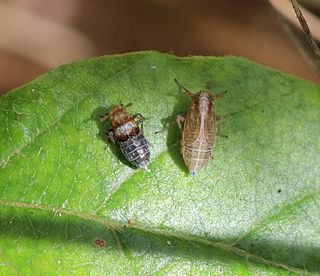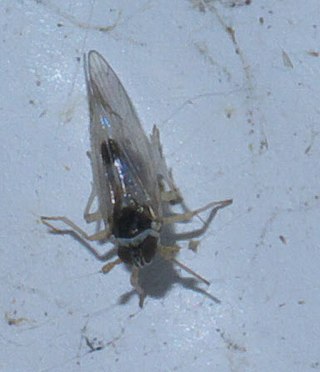Pissonotus marginatus is a species in the family Delphacidae, in the order Hemiptera . Pissonotus marginatus is found in North America.
Stobaera caldwelli is a species of delphacid planthopper in the family Delphacidae. It is found in Central America and North America.
Kosswigianella is a genus of delphacid planthoppers in the family Delphacidae. There are about 10 described species in Kosswigianella. Some authorities have placed AcanthodelphaxLe Quesne, 1964 here as a subgenus, but this is disputed.
Pissonotus brunneus is a species of delphacid planthopper in the family Delphacidae. It is found in Central America and North America.

Isodelphax is a genus of delphacid planthoppers in the family Delphacidae. There are at least 2 described species in Isodelphax.

Javesella is a genus of delphacid planthoppers in the family Delphacidae. There are at least 20 described species in Javesella.

Stobaera is a genus of delphacid planthoppers in the family Delphacidae. There are about 14 described species in Stobaera.
Tumidagena is a genus of delphacid planthoppers in the family Delphacidae. There are at least three described species in Tumidagena.

Megamelus is a genus of delphacid planthoppers in the family Delphacidae. There are at least 30 described species in Megamelus.

Nothodelphax is a genus of delphacid planthoppers in the family Delphacidae. There are more than 20 described species in Nothodelphax.
Pareuidella is a genus of delphacid planthoppers in the family Delphacidae. There are about five described species in Pareuidella.
Pentagramma is a genus of delphacid planthoppers in the family Delphacidae. There are about nine described species in Pentagramma.

Asiracinae is a subfamily of delphacid planthoppers in the family Delphacidae. There are at least 30 genera and 180 described species in Asiracinae, which probably has a world-wide distribution.

Sogatella is a genus of delphacid planthoppers in the family Delphacidae. There are more than 20 described species in Sogatella.
Pygospina is a genus of delphacid planthoppers in the family Delphacidae. There are about five described species in Pygospina.

Stenocranus is a genus of delphacid planthoppers in the family Delphacidae. There are more than 70 described species in Stenocranus.
Pissonotus delicatus is a species of delphacid planthopper in the family Delphacidae. It is found in the Caribbean, Central America, and North America.
Syndelphax is a genus of planthoppers in the family Delphacidae, comprising 19 species:
Laccocera is a genus of delphacid planthoppers in the family Delphacidae. There are about 10 described species in Laccocera.

Chionomus is a genus of delphacid planthoppers in the family Delphacidae. There are about 14 described species in Chionomus. They are found in North, Central, and South America, including the Caribbean.









